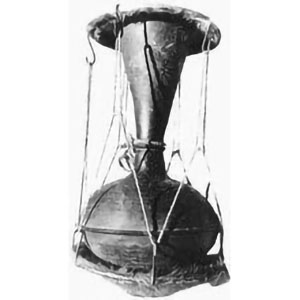fenggu overview
 The bee drum (pinyin: Fēng gǔ), a porcelain-made mixed percussion instrument, is a thin-waisted drum popular among the Zhuang, Yao and Maonan ethnic groups in Guangxi Zhuang Autonomous Region. It is named for its thin waist, thick two ends, and a drum body that resembles a bee's waist. drum". The bee drum is small in size and is often used in folk song and dance accompaniment, and is one of the essential musical instruments. In folk songs and dances, it is not only an important accompaniment instrument, but also a dance prop. It is often played and danced by the player, which is full of local characteristics.
The bee drum (pinyin: Fēng gǔ), a porcelain-made mixed percussion instrument, is a thin-waisted drum popular among the Zhuang, Yao and Maonan ethnic groups in Guangxi Zhuang Autonomous Region. It is named for its thin waist, thick two ends, and a drum body that resembles a bee's waist. drum". The bee drum is small in size and is often used in folk song and dance accompaniment, and is one of the essential musical instruments. In folk songs and dances, it is not only an important accompaniment instrument, but also a dance prop. It is often played and danced by the player, which is full of local characteristics.The drum body of the bee drum is mostly made of pottery (the drum body of the bee drum is kneaded with yellow mud, and then fired into a kiln for ceramics), with a broad head and a slender waist, thick ends and a small middle, with a total length of 50-64 cm. One end is spherical, the drum surface is small, the maximum diameter is 20~22 cm, the top open (drum surface) is small, the diameter is only 7~10.5 cm; the other end of the drum cavity is trumpet-shaped, the drum surface is larger, the diameter 16~19 cm. The drum waist is as thin as a bee waist, with a diameter of 5.8-8 cm. The two ends of the drum cavity are connected, the wall thickness is 1 cm, and the middle connection is thin and solid, shaped like a bee waist. Both ends of the drum are covered with cowhide or sheepskin, and the drum skin is attached to a circular iron ring. There are several iron hooks around the iron ring, which are connected and fastened by ropes. The tension of the drum skin can be adjusted to change the pitch and timbre. . In Jingxi County, Baise, Guangxi and other places, there are also wooden bee drums. The drum skin is not tightened with ropes, but is directly fixed at both ends of the drum with drum nails. decoration, the appearance is also very beautiful.
When playing the bee drum, tie the bee drum with a ribbon and hang it horizontally in front of the abdomen or chest. The spherical end of the drum face is placed on the left, and the trumpet-shaped drum face is placed on the right side. You can use both hands to slap the drum faces at both ends. You can also use your left hand to hold a wooden or bamboo round head drum to strike the left spherical-end drum surface, and use your right hand to slap the right trumpet-shaped end drum surface. The drumhead at the bulbous end of the bee drum emits a crisp and bright "da-da" sound (treble); the drumhead at the horn-shaped end emits a deep and rich "tongtong" (bass). Although the pitches of the sounds emitted at both ends are not fixed, they are usually fifths. It is often used in ensembles together with folk instruments such as small drums, gongs, cymbals, and bells, and is also used as an accompaniment for folk songs and dances such as Shigong Opera, Shigong Dance, and Bee Dance. The sound of the ceramic bee drum is clear and bright; the wooden bee drum is soft and pleasant. The bee drum can also be played on a drum stand.
- Pinyin:Fēng gǔ
- type:percussion
- popular area:Guangxi Zhuang Autonomous Region Zhuang, Yao and Maonan, etc.
- alias:Yue drum, horizontal drum, Mengyan, yellow mud drum
reference materials and contributors
- 蜂鼓 · 百度百科
- 蜂鼓 · 快懂百科
- 蜂鼓 · 搜狗百科
- 声情并茂听蜂鼓—壮族蜂鼓 · 美篇
- 这座三代人精心呵护的民乐殿堂,奏响古韵今声 · 搜狐网
overview of other similar instruments
- sanyanxiao overview
- Daguangxian overview
- Leiqin overview
- hahao overview
- yandundagu overview
- Han Xiaozheng overview
- Fang Xiang overview
- guanzi overview
- zhuqin (Dao Qin) overview
- zhuiqin overview
- bangzi overview
- three-stringed piano overview
- Gehu overview
- xiao overview
- xiaokonghou overview
- Konghou overview
- Sheng overview
- suona overview
- hulusi overview
- gushao overview
 渝公网安备 50010702504639号
渝公网安备 50010702504639号